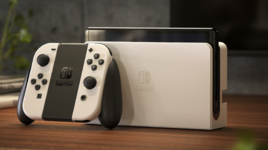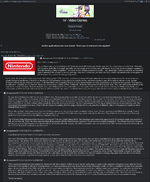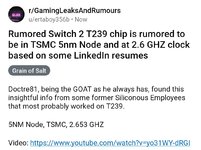Note: A lot of reading ahead -->Hey, so there's been a lot of excitement with Switch successor information over the last week and now I want to put out some of my information. Just enough to clarify bits of outdated information and corroborate some of what's been said already. In summary, is the excitement warranted? Is Nintendo returning to being competitive? The answer to both of these questions is actually... yes, shockingly! I believe we are in for an interesting console generation like we used to have 20 years ago. Sony and Microsoft are just barely starting to release real generationally-bound games for their hardware. This is where the next-gen truly starts.
So first of all, the claim of the Switch successor's SoC still being that "T239" were true, but that was back in 2019 before Nintendo was forced to cut the Switch Pro. In fact Nvidia was already hesitant to provide this to Nintendo by the time the T239 got leaked. It was going to be used for the Pro, and simply put that's been off the table for well over a year. Besides Nintendo's attitude change in the last two years, Nvidia themselves were pressuring Nintendo to move beyond Ampere. As many people feared, as evident by the supposed "Samsung 8nm reconfirmation" yesterday and its response, Samsung's process node is simply terrible. Additionally, developers have pressured Nintendo a lot lately. They want their games available on the huge Switch market. And finally Nintendo started to crack when Nvidia joined in that conversation from their corner of the room. It took a lot of convincing but Nvidia-mostly finally, and successfully, got Nintendo leadership to accept that the T239 was not the right choice. It could not hit the battery life targets Nintendo desired while also providing the feature set they want.
So what does that leave you with? No, it's not a Mediatek SoC, Nintendo genuinely enjoys their partnership with Nvidia due to similar business philosophies. The newer SoC has the model name T254. If you're on top of your Nvidia silicon, you might deduce what this is already from those numbers. But I'll spell it out regardless. This SoC is the cut-down remnant of what was going to be Atlan, the "cancelled" SoC made for Nvidia Drive. What's funny is there's a subtle hint this design would show up again in Jensen's announcement of Thor. All he says is that Atlan is "no more" and he's talking specifically about their automotive products. The main improvements from Thor are all related to features those companies want. The Atlan-based Drive module is no more. What Nvidia did, instead of sweeping all of the design work into the bin, was pass it on to Nintendo. After all of the pressure I mentioned above, Nintendo finally bit on it.Why is this exciting? T254 is much better than what T239 was going to be. Ada Lovelace scales remarkably at lower power. Another advantage is that Nintendo is actually *saving* money at-scale because of the amount of dies they are getting per-wafer from TSMC (this was a huge factor, obviously, for Nintendo). They would have had to bin a lot of Samsung's production to even come close to the efficiency requirement they set.The 4K Breath of the Wild presentation showed at Gamescom? That was running without DLSS. The presenters were meant to be vague about DLSS because people were expected to talk, and talk they did. That's why there were immediate disagreements with the version/features supported. People incorrectly making assumptions. The software stack isn't complete and the goal is to get Ray Reconstruction into the SDK by launch (this will easily happen). The Matrix presentation was running internally at 1440p and upscaling to 4K and actually was on DLSS 3.0. None of the publications got that correct.
I myself am excited for Nintendo to once again care about core gamers.Why now? The bottom line is they believe that because the Switch already established such a large market, they can obtain more third-party game sales for the successor which they missed out on. They already know consumers will buy anything first-party, for almost any price, and the post-Covid market and PS5 proved to them expensive hardware will too. Something that surprised me, based on my own interpretation, is that I think Nintendo leadership is excited themselves to surprise everyone. It has been quite invigorating for them lately. There are a couple other pieces of generic hardware information I can provide. Storage will be a basic PCI Express 4.0-based NVME SSD. Nintendo is saving on cost here because this is cheap and performant enough today, without overengineering. Storage quantity is an unknown for me except for one detail. I'll get to that in a second. The USB support is either USB4 20Gbps or USB4 40Gbps. This is kind of funny, to me at least, that the deciding factor here is going to be the cables. They haven't decided if they want to deal with the added expense of higher quality cable validation for 40Gbps. Electronically it will work but 40Gbps is likely getting soft-locked out - I would put my money on that. There's hardly a reason to need faster speeds. The expandable storage that will be possible over USB4 either way will be plenty fast. And that's how Nintendo is going to manage large game sizes this time around without requiring them to put in a huge internal storage capacity, so they get to keep the initial console price more reasonable.
There was another feature set demo planned for Gamescom that didn't make it. A Mario 64-style Peach's castle stage. It was/is (might come later still) going to show what the Switch successor will be capable of with native rendering versus DLSS-enhanced rendering for both docked and handheld performance profile. So that's 4 comparisons in total. It has geometric grass, denser than Breath of the Wild's but shorter, and with much further draw distance. Most impressive here is each individual blade casts a shadow. The castle moat obviously has path traced reflections but the reflective depth is impressive. There are window reflections coming through the water's own reflections. Every detail represented in this sandbox is meticulous. Very high resolution textures, dense tree canopy and foliage. All the works. It's not realistic for a game, but that's why it's a developer demo. This didn't make it to Germany because of the software stack not being ready yet. It doesn't run well at the moment but it's expected to get it to a stable 30 frames per second as-is once preproduction-ready.Thanks for reading!






